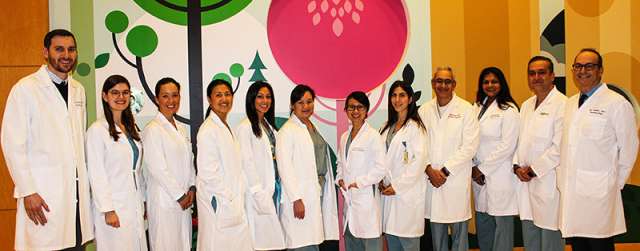Pediatric Anesthesiology

The pediatric anesthesiology team is dedicated to providing care for patients at UCLA Mattel Children's Hospital, which has been named among the nation's top pediatric medical centers by U.S. News & World Report. As a team, we provide anesthesia services to all children – from healthy to critically ill, premature to adolescent – while also encompassing care for the medically complex congenital adult population.
Our skilled pediatric anesthesiologists care for patients undergoing a wide range of major surgeries, including organ transplantations, craniofacial reconstruction, neurosurgery, trauma, and open heart surgery for repair of congenital heart disease. Additionally, our staff works in conjunction with various other pediatric subspecialties to provide sedation and analgesia for therapeutic and diagnostic studies, both in outpatient and inpatient settings. These can include MRI, CT-scan, cardiac catheterization, interventional radiology, and endoscopy, as well as bone-marrow biopsy, lumbar puncture and radiation therapy.
Moreover, our pediatric anesthesiology team plays an integral part in UCLA's global health initiatives. Our members are intimately involved in the care of children from different parts of the world, who are transferred to UCLA Mattel Children's Hospital for a higher level of medical care. Many of our own staff even volunteer their expertise for medical missions all over the world with an aim to share their knowledge with local medical communities.
What is a pediatric anesthesiologist?
A pediatric anesthesiologist is responsible for tailoring and administering general anesthesia, sedation and pain management based on each child's specific needs. Pediatric anesthesiologists are physicians who have completed at least four years of medical school, one year of internship and three years of residency in anesthesiology with additional specialty training in pediatric anesthesiology.
Working closely with the surgical team, the role of the pediatric anesthesiologist includes medically evaluating a child to create a thorough plan ensuring a calm and safe environment before, during and after their procedure. Many children who require surgery or various procedures often have very complex medical diagnoses for which a pediatric anesthesiologist is best qualified to evaluate. These physicians are trained to administer and manage pediatric medications, while minimizing any negative side effects, to ensure each child remains comfortable and free of pain throughout (and after) their procedure. They are also knowledgeable about the potential psychological needs of children undergoing any type of medical procedure. Our team at UCLA utilizes a multi-disciplinary approach, often collaborating with UCLA Chase Child Life Program to help provide appropriate measures for the easiest possible transition to the operating room. This may include administration of sedative medication and/or other non-pharmacological approaches.
Concerns regarding anesthesia and the developing brain
For every child undergoing anesthesia at UCLA, an important part of the surgical decision-making process is determining all risks involved and weighing the option to post-pone a surgery or procedure until the child is older in age. Most often, however, the delay presents a greater risk.
More preclinical and clinical studies are necessary to determine anesthetic injury in infants and young children. The International Anesthesia Research Society (IARS) and the US Food and Drug Administration (FDA) are currently working on a multi-year project called "SmartTots" that continues to facilitate and support ongoing studies of existing anesthetic drugs and their effects on childhood development.
It is evident that there are a vast majority of children who currently undergo anesthesia with no notable changes to their development. Nonetheless, our pediatric anesthesiology team here at UCLA will continue to update our practice guidelines and make necessary adjustments in support of the most evidenced-based research to date. Please know our priority is the safety of our pediatric patients, as is practicing optimal anesthesia techniques to provide the best overall surgical experience for every child.
To learn more, we recommend the following:
- FAQ's for Parents & the Public - Smart Tots
- "Consensus Statement Following December 2016 FDA Warning"
Additional Information:
- If your child is scheduled to undergo anesthesia, we strongly encourage you to visit "What to Know About Anesthesia" and "Preparing for Surgery"
- If you have any questions regarding anesthesia for your child, please speak with the anesthesiologist the morning of your child's surgery or procedure. Additionally, you may email us at [email protected]. We will make every effort to respond as soon as possible.
- Society for Pediatric Anesthesia